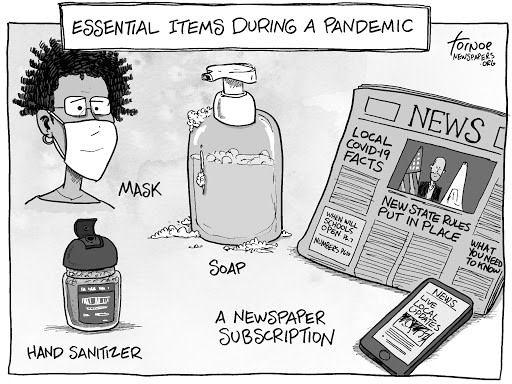
Dear Ms. Smartphone: I see your point about civics and reading a newspaper or magazine with kids at home (I have one in college and three at home). But, it’s really impossible to get it delivered where we live. The paper ends up not coming most days, and when it does, it lands in a boggy part of our lawn. Sometimes it just disappears. So, what’s wrong with digital content and newspapers? Ollie, Oakland
Dear Ollie, Here’s the irony. Publishers believe that people are turning to digital content for newspapers because they prefer it. Actually, the exodus from tree pulp from starts with the little things like a dialogue with the overseas call center or a wonky web site. It’s hard to reach a human and stop or start a delivery. Often, as you note, the paper doesn’t come at all.
Shared experience
The major reason I advocate that you and your children still read a physical newspaper is that it can be a shared experience. If you read the news on a phone or a tablet your children don’t know whether you are looking at a story, browsing for a new car, scrolling Facebook, or playing a video game. And, reciprocally, as a parent, you don’t know what they are doing either. With that in mind, you might if the budget allows, reserve a laptop for their schoolwork and a separate device, say an Xbox, for social and games. That way you can keep better tabs.
You also want to read the physical newspaper because context matters as well as content. Say you are reading topical news stories about the subway collapse in Mexico City. Your children might be afraid to ride BART and take public transportation after they see the pictures. You have the opportunity to provide background, and impart them with knowledge that this is a very rare event.
Reading light and deep
But, another reason for reading the newspaper, think academic again, is that it inculcates better reading skills. With a digital paper, readers are more likely to skim and not go in depth- despite the opportunity to use outside links and sources. I have previously written about the differences between reading in print versus reading digitally. But, if your kids are doing research, the digital paper might be valuable, particularly for highly visual articles and timelines.
On the Internet- when Facebook or Twitter delivers the news, we experience a “filter bubble,” so named by A. Parnisi back in 2010. Based on your expressed interests and past viewings, an algorithm predicts stories that will engage you. It winnows the news stories into into a handful of items that you will click on. That click, in turn, initiates ads, targeted just for you. When you read a print paper, the “filter bubble” is bigger- an editorial staff picks and prints say 30 stories a day and there’s no linking between ads, clicks, and customers. And, there is the serendipity of discovering something you and your family would not normally see or read.
Breaking the Breaking Cycle
That said, Facebook and Twitter are the hands-down winner when it comes to hearing late-breaking, real-time news stories. The print newspaper cannot compete. However, and it’s a serious question, are we the wiser for this, or is it another type of distraction? Almost all breaking news stories are of a distant environments that we cannot act upon or control. Should there be a news event of local significance, say an out-of-control fire or a traffic jam-up, you are likely to get notifications on your phone. Watching a distant breaking new story, in this case, news of the Boston Marathon bombing, was associated with impacts on mental well being.
So, summing up, what do you do when the newspaper doesn’t quite make it to your doorstep. Perhaps you can subscribe to media that comes in the post, like a weekly magazine. Or you can make a fun trip on foot or in the car to get a latte and a newspaper. Both cost about the same, and you can share the latter. Most public libraries have both print and digital editions of papers, but that is not going to help you with the family time.

Leave a Reply
You must be logged in to post a comment.